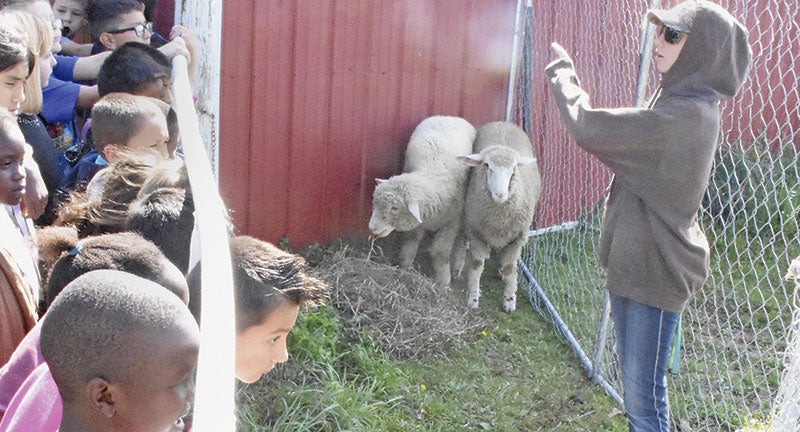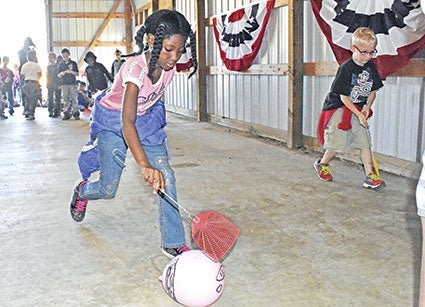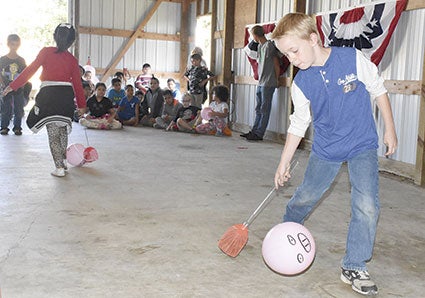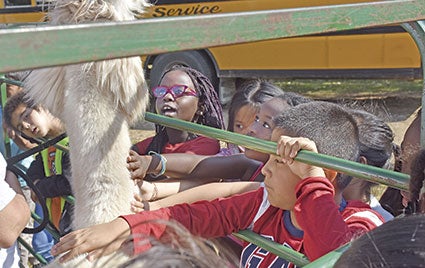5 things kids learned at their Day on the Farm; More than 400 students visit 3 Austin area family operations
Published 8:17 am Thursday, September 21, 2017

- Austin High School FFA member Summer Davis talks about Suffolk and Dorsett crossbred sheep on Tuesday at Darryl Ingvaldson’s farm during the Austin Area Chamber of Commerce’s annual Day on the Farm for third-grade students. Photos by Chris Baldus/chris.baldus@austindailyherald.com
Summer Davis and two ewes were surrounded and fenced in at the Ingvaldson Farm.
Behind them, a herd of Simmental cattle brayed here and there, usually as she began to speak to the crowd of third-graders pressing against the livestock panel in front of Davis.
Her partner from the Austin High School FFA asked the children from Sumner Elementary School where they thought the cattle came from.
“Utah!” a boy yelled from the pack.
Well, they are originally from a place with mountains — Switzerland.
Three farms hosted more than 400 children Tuesday for the Austin Area Chamber of Commerce’s annual Day on the Farm. Here are four other things they learned:

Sumner Elementary student Enqr Zaki, 8, guides her balloon pig with a flyswatter during a race Tuesday at Darryl Ingvaldson’s farm during the Austin Area Chamber of Commerce’s annual Day on the Farm.
How to steer a hog
At the Darrell Ingvaldson farm about two miles east of the Austin Country Club, children saw steers, llamas, chickens and ducks. They also got a lesson in steering a hog where to go. You use a stick, FFA volunteers explained as they handed children flyswatters to guide balloon “pigs” in a relay race. A key point: tap, don’t hit the pig to guide it along.
A pumpkin can be pink, for a cause
John and Jan Ulland were on hand at the Ingvaldson Farm and among the gourds, pumpkins and vegetables they had on display from the Farmer John Pumpkin Patch, was a large, glossy pink pumpkin. The Ullands grow the pumpkins to help the Pink Pumpkin Patch Foundation support breast cancer research.
In February, the foundation announced awarding a $15,000 breast cancer research grant to The Hormel Institute.
The Ullands also provided a regular pumpkin for each class to take back to school.

Sumner Elementary student Kenneth Wright, 8, guides her balloon pig with a flyswatter during a race Tuesday at Darryl Ingvaldson’s farm during the Austin Area Chamber of Commerce’s annual Day on the Farm.
What cows eat, besides grass
At the Sayles Dairy Farm, where Dean Sayles, his sons Craig and Scott, and his brother, Wayne, milk between 160-180 Holstein cows, students visited the milking parlor and calf barn and learned what cows eat.
The Sayles put out containers of the types of feed they give their cows: corn silage, haylage, distiller grains, protein pellets and regular corn.
Drones have farm uses
A North Country Coop demonstrated at the Sayles Farm how flying a drone can be useful to farmers when it comes to surveying field conditions. Students were able to see the drone in action and see the photos it took from the air.
“The milking parlor and the drone were probably the two biggest things (that interested the students,” Craig Sayles said.
Students also visited the Larry Gerlach Farm, where they saw the hog operation and several pieces of large farm equipment. An agronomy station provided information on how commodities, such as corn and soybeans, are processed into foods, the news release said.

Sumner Elementary students pet and look over a one of Julie Hendrikson’s llamas Tuesday at Darryl Ingvaldson’s farm during the Austin Area Chamber of Commerce’s annual Day on the Farm. Photos by Christopher Baldus/chris.baldus@austindailyherald.com



